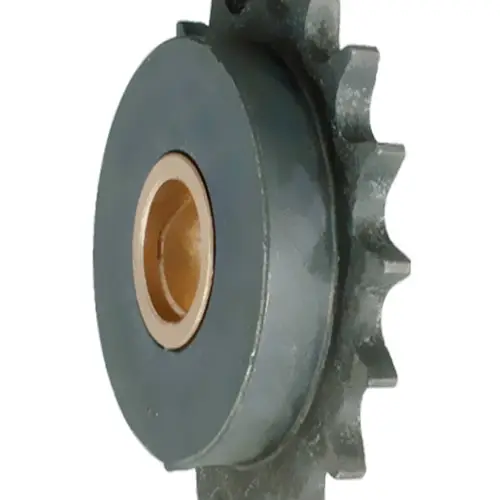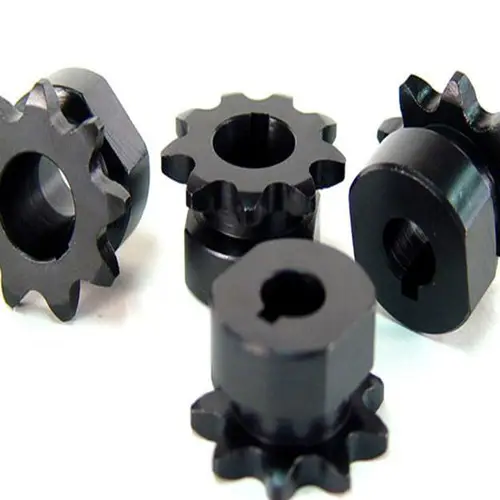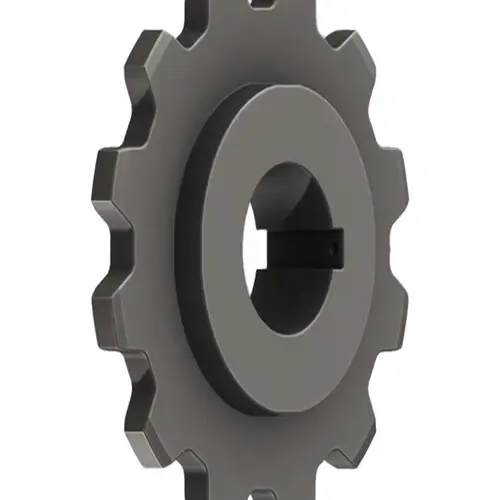
China OEM Bronze Bearing Idler Sprockets and Industrial Components
Product Description
Our bronze bearing idler sprockets are expertly crafted for diverse applications, ranging from salt spreaders to oil fields. These components are stamped, flame cut, and made from robust cast iron, ensuring durability and optimal performance. The silent chain ladder with extended pitch hinge top split hub combination pintle is designed to meet various industrial needs.
Key Features
- High-quality bronze bearing idler sprockets
- Suitable for salt spreaders and oil field applications
- Stamped and flame cut for precision
- Durable cast iron construction
- Silent chain ladder with extended pitch hinge top split hub
Wide Range of Sprockets
We manufacture a diverse range of sprockets, including chain sprockets, wheel and drive sprockets, taper lock sprockets, gear sprockets, idle sprockets, motorcycle sprockets, and stainless steel sprockets. Our products are designed to interchange and replace Martin size sprockets, JT size sprockets, DID size chain sprockets, and more, ensuring versatility and compatibility.
Other Product Offerings
EVER-POWER GROUP offers a comprehensive range of industrial products, including:
- Agricultural gearboxes
- Power output shafts
- Sprockets and fluid couplings
- Worm gear reducers
- Gears and racks
- Roller chains, pulleys, and planetary gearboxes
- Timing pulleys and bushings
We are committed to providing high-quality products at competitive prices, backed by excellent customer service. Customization based on drawings and samples is welcome.
FAQs
1. What materials are used in the bronze bearing idler sprockets?
Our bronze bearing idler sprockets are made from high-quality cast iron, ensuring durability and longevity.
2. Can these sprockets be used in oil field applications?
Yes, our bronze bearing idler sprockets are specifically designed for use in oil fields and other demanding environments.
3. Are your sprockets compatible with other brands?
Our sprockets are designed to interchange and replace Martin size sprockets, JT size sprockets, DID size chain sprockets, and more.
4. Do you offer custom sprocket designs?
Yes, we welcome customization based on customer drawings and samples to meet specific requirements.
5. What other products do you offer?
In addition to sprockets, we offer agricultural gearboxes, power output shafts, fluid couplings, worm gear reducers, gears and racks, roller chains, pulleys, and more.
All the content of the page is from the Internet, the content is only as a reference for product selection, our products are replacement parts and not original spare parts; we are not the holder of the original trademarks of the content, our products are only suitable for after-sales replacement parts and not original spare parts, our replacement parts can be perfectly adapted to the original spare parts; if you need to buy original spare parts, please contact the original factory to buy. If you want to buy original spare parts, please contact the original supplier for purchase.
Performance Characteristics of Ladder Sprocket
Ladder sprockets are integral components in various machinery and equipment, performing essential functions to ensure operational efficiency. Below are the key performance characteristics of ladder sprockets:
Durability
Ladder sprockets are designed to withstand heavy loads and continuous operation. Their robust construction ensures long service life, reducing the need for frequent replacements and maintenance.
Precision
These sprockets are engineered with high precision to ensure smooth and accurate engagement with the chain. This precision minimizes wear and tear on both the sprocket and the chain, enhancing overall system longevity.
Corrosion Resistance
Many ladder sprockets are made from materials that resist corrosion, such as stainless steel or specially treated alloys. This characteristic is particularly important in environments where exposure to moisture or chemicals is common.
Versatility
Ladder sprockets are versatile and can be used in a variety of applications, from conveyor systems to agricultural machinery. Their adaptability makes them a popular choice across different industries.
Types and Characteristics of Ladder Sprocket
Ladder sprockets come in various types, each with unique characteristics tailored to specific applications.
Standard Ladder Sprockets
These are the most common type, used in everyday applications where standard loads and speeds are encountered. They are typically made from durable steel and are designed for general-purpose use.
Heavy-Duty Ladder Sprockets
Designed for applications that involve heavy loads and high stresses, these sprockets are constructed from high-strength materials and often feature reinforced teeth for added durability.
Corrosion-Resistant Ladder Sprockets
Ideal for use in harsh environments, these sprockets are made from materials such as stainless steel or are coated with protective finishes to resist rust and corrosion.
Custom Ladder Sprockets
For specialized applications, custom ladder sprockets can be designed to meet specific requirements. These can include unique tooth configurations, specialized materials, and custom sizes.
Advantages of Ladder Sprockets Made of Different Materials
The material composition of a ladder sprocket significantly influences its performance and suitability for various applications.
Steel Ladder Sprockets
Steel is the most commonly used material for ladder sprockets due to its strength and durability. Steel sprockets can handle high loads and are suitable for most industrial applications.
Stainless Steel Ladder Sprockets
Stainless steel sprockets offer excellent corrosion resistance, making them ideal for use in environments where exposure to moisture or chemicals is prevalent. They are commonly used in food processing, marine, and chemical industries.
Plastic Ladder Sprockets
Plastic sprockets are lightweight and resistant to corrosion. They are suitable for applications where weight reduction is important and in environments where metal sprockets would corrode quickly.
Application of Ladder Sprockets in Various Fields
Ladder sprockets play a crucial role in various industries, contributing to the efficiency and functionality of different systems.
Conveyor Systems
Ladder sprockets are essential components in conveyor systems, facilitating the smooth and efficient movement of materials across production lines. Their durability and precision ensure minimal downtime and maintenance.
Agricultural Machinery
In agricultural machinery, ladder sprockets are used to drive chains that operate various mechanisms. Their ability to withstand harsh outdoor conditions makes them indispensable in this sector.
Construction Equipment
Construction equipment relies on ladder sprockets for the operation of heavy-duty machinery. The sprockets’ robustness and ability to handle high loads are critical for the demanding conditions of construction sites.
Pulp and Paper Industry
The pulp and paper industry uses ladder sprockets in various processing machines. Their corrosion resistance and reliability are vital for maintaining continuous and efficient operations.
Mining and Quarrying
In the mining and quarrying sector, ladder sprockets are used in equipment that handles heavy materials and operates in abrasive environments. Their strength and resistance to wear are key to withstanding the tough conditions.
Future Development Trends and Opportunities of Ladder Sprocket Products
The ladder sprocket industry is poised for growth, driven by advancements in materials and manufacturing processes.
Innovative Materials
Future developments may include the use of advanced composite materials that offer superior strength and corrosion resistance while being lightweight.
Enhanced Manufacturing Techniques
Improvements in manufacturing techniques, such as 3D printing and CNC machining, will allow for greater precision and customization of ladder sprockets.
Integration with Smart Technology
The integration of smart technology, such as sensors for real-time monitoring and predictive maintenance, can enhance the performance and reliability of ladder sprockets.
Sustainability
There is a growing emphasis on sustainability, leading to the development of eco-friendly sprockets made from recyclable or biodegradable materials.
Choosing a Suitable Ladder Sprocket
Selecting the right ladder sprocket involves considering several factors to ensure compatibility and optimal performance.
Clear Requirements
Identify the specific requirements of your application, including load capacity, speed, and environmental conditions.
Material Selection
Choose a material that offers the necessary strength, durability, and resistance to environmental factors.
Design Optimization
Ensure the sprocket design is optimized for your application, taking into account tooth configuration and size.
Suppliers and After-Sales Service
Select reputable suppliers that offer comprehensive after-sales support, including technical assistance and replacement parts.
Cost-Effectiveness
Consider the cost-effectiveness of the sprocket, balancing initial investment with long-term performance and maintenance costs.
Quality Control
Ensure the sprockets meet stringent quality control standards to guarantee reliability and performance.
Summary
Ladder sprockets are vital components in various machinery and equipment, offering durability, precision, and versatility. Understanding their performance characteristics, types, and material advantages is crucial for selecting the right sprocket for your application. The future of ladder sprockets looks promising with advancements in materials, manufacturing techniques, and smart technology integration. By considering factors such as clear requirements, material selection, design optimization, and quality control, you can make an informed decision to ensure the efficiency and reliability of your operations.
Author: Dream












